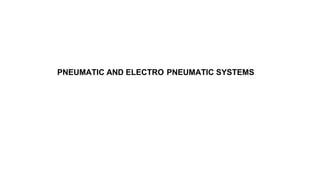
1 a. pneumatic introduction, gas laws
- 1. PNEUMATIC AND ELECTRO PNEUMATIC SYSTEMS
- 2. PNEUMATIC AND ELECTRO PNEUMATIC SYSTEMS Properties of air – Perfect Gas Laws – Compressor – Filters, Regulator, Lubricator, Muffler, Air control Valves, Quick Exhaust Valves, Pneumatic actuators, Design of Pneumatic circuit – Cascade method – Electro Pneumatic System – Elements – Ladder diagram – Problems, Introduction to fluidics and pneumatic logic circuits.
- 3. Properties of Air, GAS LAWS
- 4. 1) Gases are highly compressible • An external force compresses the gas sample and decreases its volume, removing the external force allows the gas volume to increase. 2) Gases are thermally expandable •When a gas sample is heated, its volume increases, and when it is cooled its volume decreases. 3) Gases have high viscosity • Gases flow much easier than liquids or solids. 4) Most Gases have low densities • Gas densities are on the order of grams per liter whereas liquids and solids are grams per cubic cm, 1000 times greater. 5) Gases are infinitely miscible • Gases mix in any proportion such as in air, a mixture of many gases. Properties of Gases
- 5. Properties of Gases Pressure Volume Amount (moles) Temperature
- 6. Pressure • Units of Pressure • 1 pascal (Pa) = 1 N/m2 • 1 atm = 760 mmHg = 760 torr • 1 atm = 101,325 Pa Pressure = Force Area
- 7. Volume • Volume is the three-dimensional space inside the container holding the gas. The SI unit for volume is the cubic meter, m3. A more common and convenient unit is the liter, l. • Think of a 2-liter bottle of soda to get an idea of how big a liter is. • (OK, how big two of them are…)
- 8. Amount (moles) • Amount of substance is tricky.As we’ve already learned, the SI unit for amount of substance is the mole, mol. Since we can’t count molecules, we can convert measured mass (in kg) to the number of moles, n, using the molecular or formula weight of the gas. By definition, one mole of a substance contains approximately 6.022 x 1023 particles of the substance.
- 9. Temperature Temperature is the measurement with which you’re probably most familiar (and the most complex to describe completely). For these lessons, we will be using temperature measurements in Kelvin, K.
- 10. Boyle’s Law This law is named for Charles Boyle, who studied the relationship between pressure, p, and volume, V, in the mid-1600s. He determined that for the same amount of a gas at constant temperature, p * V = constant This defines an inverse relationship: when one goes up, the other comes down. Doubling the pressure reduces the volume by half. Conversely, when the volume doubles, the pressure decreases by half.
- 11. Application of Boyle’s Law Boyle’s Law can be used to predict the interaction of pressure and volume. p1 * V1 = p2* V2 p1= initial pressure V1 = initial volume p2= final pressure V2 = final volume
- 12. Charles’ Law This law is named for Jacques Charles, who studied the relationship volume, V, and temperature, T,around the turn of the 19th century. He determined that for the same amount of a gas at constant pressure, V / T = constant This defines a direct relationship: an increase in one results in an increase in the other. As the temperature increases, the volume increases. Conversely, when the temperature decreases, volume decreases.
- 13. Partial Pressure Partial Pressure Pressure each gas in a mixture would exert if it were the only gas in the container Dalton's Law of Partial Pressures The total pressure exerted by a gas mixture is the sum of the partial pressures of the gases in that mixture. PT = P1 + P2 + P3 + .....
- 14. Application of Charles’ Law Charles’ Law can be used to predict the interaction of temperature and volume. V1 / T1= V2/ T2 V1 = initial volume T1= initial temperature V2 = final volume T2= final temperature
- 15. Charles’ Law: Summary Volume / Temperature = Constant V1/ T1= V2/ T2 With constant pressure and amount of gas, you can use these relationships to predict changes in temperature and volume.
- 16. Avogadro’s Law V number of moles (n) V = constant x n V1/n1 = V2/n2 Constant temperature Constant pressure
- 17. Ideal Gas Equation Boyle’s law: V 1 (at constant n and T) P Charles’ law: V T (at constant n and P) Avogadro’s law: V n (at constant P and T) V nT P nT P V = constant x nT = R P R is the gas constant PV = nRT
- 18. Dalton’s Law of Partial Pressures V and T are constant P1 P2 Ptotal = P1 + P2
- 19. The Nature of Gases Three basic assumptions of the kinetic theory as it applies to gases: 1. Gas is composed of particles- usually molecules or atoms – Small, hardspheres – Insignificant volume; relatively farapart from each other – No attraction or repulsionbetween particles 2. Particles in a gas move rapidly in constant random motion – Move in straight paths, changingdirection only when colliding with one another or other objects – Average speed of O2 in air at 20 oC is an amazing 1660 km/h! (1.6km=1mile) 3. Collisions are perfectly elastic- meaning kinetic energy is transferred without loss from one particle to another- the total kinetic energy remains constant.
